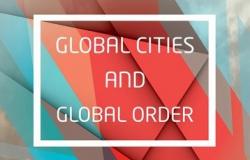Book Review - Global Cities and Global Order

Global Cities and Global Order by Simon Curtis. Oxford: Oxford University Press 2016. 240 pp, £55 hardcover 9780198744016
During the last decade, there has been an extraordinary outpouring of literature regarding the rising importance of cities, urbanism, and urbanization processes in ongoing global transformations. According to the UN, more than half of the world’s people had become city dwellers by 2007, and by 2050, 70 percent of all people are expected to live in cities. The ongoing demographic shifts are often described as having monumental importance to humanity, and sometimes even as upsetting global political balances. The idea that the future and destiny of humanity in various ways is tied to urban developments is not an isolated narrow academic idea – it is part of broad and general knowledge configurations and discourses about the contemporary state of the world.
Although an increasing amount of academic work is being written about cities in general and on global cities in particular, it is surprising how little attention this has gained in the International Relations academic community. The city may certainly be an awkward unit of analysis to state-centric IR scholars, and yet the fates of states and cities have always been closely entwined. Throughout history, cities have been key sites of societal transformations: places where revolutions begin, new life styles form, technology develops, and where new ways of organizing work, economy and politics are emerging. This is well understood among, for example, geographers and sociologists, but much less so by IR scholars.
However, during the first decade of the 21st century a small number of IR scholars started to take an interest in the rise of global cities. Simon Curtis is one of the pioneers in this growing group of scholars. His most recent book Global Cities and Global Order is a significant and long overdue contribution to IR theory which firmly places the rise of the global city within a context of contemporary global transformations. In a sophisticated and historically sensitive manner, it combines the insights from global city scholarship with IR theory on international order and systemic change. It makes the crucial link between the transformation in urban form represented by the rise of global cities – a fundamentally novel form of city – and the ongoing transformation of both the state and the international system.
The argument may seem bold to most IR scholars: cities are playing a central role in the contemporary global political order. Curtis argues that if we are to fully account for and understand contemporary international transformations, we need to take into consideration the rise of the global city. Global cities will according to Curtis be central to international politics of the twenty-first century, not just as actors in world politics, but as strategic sites that manifest some of the yet to be resolved contradictions within the global order.
However, such argument makes perfect sense if we appreciate the historical entanglement of the fates of states and cities. Curtis applies a longue durée approach to international systemic change, but shows in particular how the rise of the global city in the late-twentieth century was facilitated by the state itself, mainly so by hegemonic leading states in the second half of the twentieth century, and by the US’s ability to shape international norms in particular. Curtis thereby examines the mechanisms by which cities have become empowered in the last few decades, and in so doing we can also understand the new role of global cities in contemporary global politics. Global cities can according to Curtis be understood as an inscription of the ideals of market society in space, as they embody a set of neoliberal principles. They also focus and amplify the tensions and contradictions within the contemporary international system, and become key sites for struggles over social justice.
The focus in this book is very much on core IR questions such as the nature of sovereignty, and on the tension between a territorial political logic and a transnational neoliberal economic logic. Curtis’s discussion on this particular tension in the international system is especially illuminating. The economic logic is winning out, and this is paradoxically the result of the (neoliberal) politics pursued by the territorial state itself.
While the vital role of cities in this paradoxical global order has represented a blind spot in the field of IR, there has at the same time according to Curtis been a striking inability in the global cities literature to take into consideration the configuration of the international system, at least beyond pure economism. As much as he introduces global city scholarship to an IR audience, he therefore also presents IR international system theorizing to a global cities audience. Curtis argues in favor of an English School understanding of the world order, and draws primarily on the writings of Barry Buzan and Richard Little. But Curtis draws from a very broad range of scholarly fields and intellectuals, some of the most notable being Karl Polanyi, Saskia Sassen, Manuel Castells and Henri Lefebvre.
Curtis binds together his overall argument through three central themes which runs through the book. The first deals with socio-technical assemblages, the second with ongoing dialectic of capital and territory, and the third with international order. The city stands on the very fault lines where these empirical-analytical themes intersect. In a sense, the book reads very much like a thorough review of scholarly thinking and theorizing within each of these themes. But we are not only presented with the intellectual history of scholarly thinking: we also get a fairly thorough history lesson. Through his longue durée approach, Curtis presents us with the city in history from hunter-gatherer society, to settlement, the emergence of cities, the birth of industrial cities and finally the rise of global cities.
In one sense it is striking how little of what Curtis writes about is actually ‘new’, and how little of the stuff of which his book is made cannot be found in various and scattered parts of social science research. And still, the sophisticated bringing together of these various bodies of knowledge means that the whole becomes greater than the sum of its parts. Curtis’s book is a truly genuine intellectual work. The rather disparate research traditions included in this book have up until now not really spoken to each other, and the way in which Curtis brings them together brings forth a highly illuminating fusion of theoretical thinking about our contemporary world order, as well as an explanation for how we got here. One of the central insights concerns how urban form has changed throughout history along with systemic change in international order. It is not only the fate of the city and the state that has been historically entangled – the international system must be part of the equation as well. In fact, currently we should put our focus on the trinity of the global city, the state and the global order.
If there is one thing I am left wondering after reading Curtis’s book, it is the question of global city agency. What kind of actor is the global city? Curtis explicitly states that global cities now have the capacity to participate in meaningful ways in global politics and he refers throughout the book to various aspects of global city agency, capacity or power within for example the realm of security, in global climate governance or in various transnational municipal networks. However, the question of actorness is still an aspect of the global city which remains undefined. Curtis warns us not to think of cities (or for that matter states) in bounded terms, and briefly suggests the application of assemblage theory instead. However, I wish that Curtis had also elaborated further on how the global city understood as assemblage can help us understand its power, capacity or agency in global politics more specifically.
Nonetheless, this book serves as a great introduction to IR theory for students in urban studies, as well as introducing global city theory to students of IR. More importantly, the valuable theoretical insights certainly ensure that scholars at any level on either side will find this book of great value.
Dr. Kristin Ljungkvist is Lecturer in the Department of Government and Institute for Housing and Urban Research, Uppsala University, and Non-Resident Fellow at the Chicago Council on Global Affairs.


